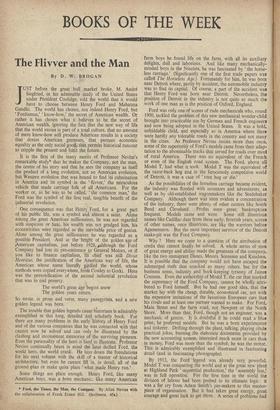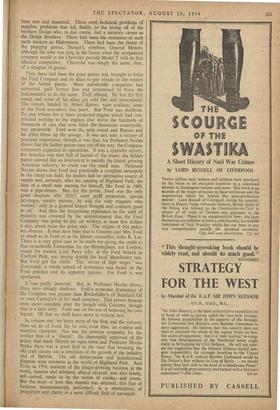BOOKS OF THE WEEK
The Flivver and the Man
By D. W. BROGAN
irUST before the great bull market broke, M. Andre Siegfried, in his admirable study of the United States under President Coolidge,' told the world that it would have to choose between Henry Ford and Mahatma Gandhi. The world has chosen, not indeed Henry Ford, but ' Fordismus," know-how,' the secret of American wealth. Or rather it has chosen what ' it believes to be the secret of American wealth, ignoring the fact that the new way of life that the world envies is part of a total culture, that no amount of mere know-how will produce American results in a society that denies American premises, that pursues economic equality as the only social good, that permits historical rancour to cripple the present and limit the future.
It is the first of the many merits of Professor Nevins's remarkable study* that he makes the Company, not the man, the centre of his story and that he sees the company as itself the product of a long evolution, not an American evolution, but Western evolution that was bound to find its culmination in America and its symbol in the ' flivver,' the miraculous vehicle that made carriage folk of all Americans. For the worker or, as he was to be called, ' the common man,' the Ford was the symbol of the' first real, tangible benefit of the industrial revolution.
' One consequence was that Henry Ford, for a great. part of his public life, was a symbol and almost a saint. Alone among, the great American millionaires, he was not regarded with suspicion or hate, his wealth was not grudged him, his eccentricities were regarded as the inevitable price of genius. Alone among the great millionaires he was regarded as a possible President. And at the height of the golden age of American capitalism, just before 1929. *although the Ford Company had lost its pre-eminence to General Motors, or if you like to finance capitalism, its chief was still Divus Henricus, the justification of the American way of life, the American whose name literally girdled the world, whose methods were copied everywhere, froth Cowley to Gorki. Here was the personification of the second industrial revolution that was to end poverty.
The world's great age begins anew The golden years return.'
So wrote, in prose and verse, many panegyrists, and a new golden legend was born.
The trouble that golden legends cause historians is admirably exemplified in this long, detailed and scholarly book. For there are many problems in the early history of Henry Ford and of the various companies that he was connected viith that cannot now be solved- and can only be illustrated by the clashing and inconsistent memories of the surviving pioneers. Even the personality of the hero is hard to illustrate. Professor Nevins continually bears in mind the later deified Ford, the world hero, the world crank. He lays down the foundations for his next volume with the skill of a master of‘ historical architecture, but even he cannot fill in, in detail, all of the ground plan or make quite plain ' what made Henry run.'
Some things are plain enough. Henry Ford, like many American boys, was a born mechanic; like many American
* Ford, the Times, the Man, the Company. By Allan Nevins with the collaboration of Frank Ernest Hill. (Scribners. 451.)
farm boys he found life on 'the farm, with all its auxiliary delights, dull and laborious. And like many mechanically- minded boys in the Nineties, he was fascinated by the horse- less carriage.' (Significantly one of the first trade papers was called The Horseless Age.) Fortunately for him, he was born near Detroit where, partly by accident, the automobile industry was to find its capital. Of course, a part of the accident was that Henry Ford was born near Detroit. Nevertheless, the • position of Detroit in the industry is not quite so much the work of one man as is the position of Oxford, England.
Ford was only one of scores of rude mechanicals who, round 1900, tackled the problem of this new mechanical wonder-child brought into practicable use by German and French engineers and now being adopted in the United States. It was a bold, unbiddable child, and especially so in America where there were hardly any tolerable roads in the country and not many in the cities. As Professor Nevins insists more than once, some of the superiority of Ford's models came from their adap- tation to the abominable tracks that served for roads over most of rural America. There was no equivalent of the French or even of the English road system. The Ford, above all Model T, had what it took. Model T was the equivalent of the razor-back hog and in the ferociously competitive world of Detroit, it was a case of ' root hog or die.'
As the possibilities of the horseless carriage became evident. the industry was flooded with inventors and adventurers, as well as by old-established wagonmakers like the Studebaker Company. Although there was soon evident a concentration of the industry, there were plenty of other centres like South Bend and Cleveland. Profits were great; bankruptcies frequent. Models came and went. Some still illustrious names like Cadillac date from these early, feverish years, scores of other names, once illustrious, are like the warriors before Agamemnon. But the most important survivor of the Detroit snake-pit was the Ford Company.
Why ? Here we come to a question of the attribution of credit that cannot finally be solved. A whole series of, men of great energy and ability made the greatness of the company. like the two immigrant Danes, Messrs. Sorensen and Knudsen. It is possible that the company would not have escaped the submerged reefs that wrecked so many others, but for the business sense, industry and book-keeping tyranny of James Couzens. Even the authorship of Model T, the car that marked the supremacy of the ,Ford Company, cannot be wholly attri- buted to Ford himself. But he had one good idea, that the market lay with the cheap, durable, economical car, not with the expensive imitations of the luxurious European cars that his rivals and at least one partner wanted to make. For Ford, Main Street and the farm road, not Newport or the North Shore. More than that, Ford, though not an engineer, was a mechanic of genius. It is _doubtful if he could read a blue print; he preferred models. But he was a born experimenter and tinkerer. Drifting through the plant, talking, playing crude practical jokes, burning the elaborate documents provided by the new accounting system, interested much more in cars than in money, Ford was more than the symbol; he was the motor. This is admirably exemplified and illustrated in fascinating detail (and in fascinating photographs).
By 1913, the Ford legend was already very_ powerful. Model T was conquering the world and at the great new plant at Highland Park ' sequential production,' the assembly line: was in full operation. For the first time in the World the division of labour had been pushed to its ultimate logic : it was a far cry from Adam Smith's pin-makers to this master- . piece of organisation. But it had taken great energy, great courage and great luck to get there. A series of problems had been met and mastered. There were technical problems of supplies, problems that led, finally, to the hiving off of the brothers Dodge who, in due course, had a meteoric career as the Dodge Brothers. There had been the extrusion of such early backers as Malcomson. There had been the threat of the plunging genius, Durant's, combine, General Motors, although the time was long in the future when the reorganised company would in the Chevrolet provide Model T with its first effective competitior:. Chevrolet was simply the name, then, of a designer of genius.
Then there had been the great patent suit, brought to force he Ford Company and its allies to pay tribute to the owners • f the Selden patent. Most automobile companies had submitted, paid licence fees and determined to force the independents to do the same. Ford refused. He lost the first round and some of his allies got cold feet and surrendered.
The victors, headed by Albert Reeves, were exultant; some of the Ford executives lost heart. But Ford was stubborn.
To pay tribute for a mere projected, engine which had con- ibuted nothing to the engines that drove the hundreds of housands of cars that now filled the 'American countryside, was intolerable. Ford won the next round and Reeves and his allies threw up the sponge. It was not only a victory of practical importance, though it was that, for Professor Nevins shows that the Selden patent once out of the way, the Company immensely expanded its operations. It was a symbolic victory, for America was then full of hatred of the trusts; the Selden patent seemed like an instrument to ttiustify the fastest growing American industry, to crush out the small man. Professor Nevins shows that Ford had practically a complete monopoly in the cheap car field; his dealers had no alternative source of, supply and, certainly, after the opening of Highland Park, the idea of a small man starting for himself, like Ford in 1900, was a pipe-dream. But, for the public, Ford was the only great magnate who didn't want tariff protection, special privileges, master patents; he was the only magnate who worked ' only in a general honest thought and common good to all.' And then the burgeoning reputation as the saint of industry was crowned by the announcement that the Ford Company was going to pay all workers at least five dollars a day, about twice the going rate. The origins of this policy are obscure. It may have been due to Couzens and Mrs. Ford as much as to Ford or to his labour counsellor, John R. Lee. There is a very good case to be made for giving the credit to that remarkable Edwardian (in the Birmingham, not London, sense) the present Lord Perry who, at the Ford branch at Trafford Park, was paying double the local Manchester rate. But Ford got the credit. The 'secret of high wages' was discovered; a whole school of economics was based on the Ford practice and its apparent success. For Ford it was apotheosis.
It 'was partly deserved. But, as Professor Nevins shows, there were already shadows. Ford's economic dominance of the Company was greater than Rockefeller's of Standard Oil or even Carnegie's of his steel company. This power became even more complete after the breach with Couzens, though that is a later story. Ford was on the eve of believing his own legend. Of that we shall learn more in volume two.
In, volume one, we learn more of the firm and the industry than we do of Ford, for he was, even then, an evasive and secretive character. Nor was his genuine sympathy for the worker that of a ' liberal.' He thoroughly approved of the policy that made Detroit an open town and Professor Nevins thinks there was a good deal in the view that breaking the old craft 'unions was a condition of the growth of the industry and of Detroit. The old demarcation and jurisdictional disputes were nonsense in the world of Highland Park. And Ford, in 1914, autocrat of the fastest-growing business in the world, famous and admired, almost revered, was also lonely, self-centred, ready to be the victim of cranks—and worse. But the story of how this summit was attained, this feat of business mountaineering performed, is a masterpiece of proportion and clarity in a most difficult field of narration.



































 Previous page
Previous page